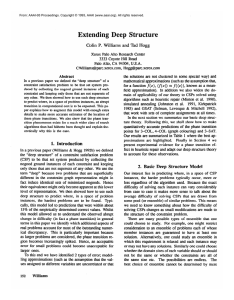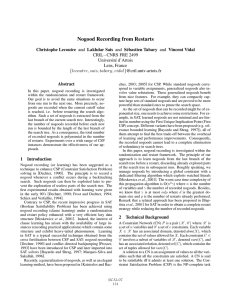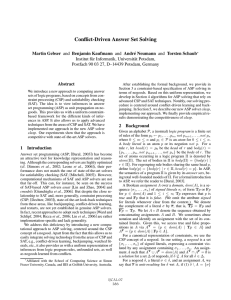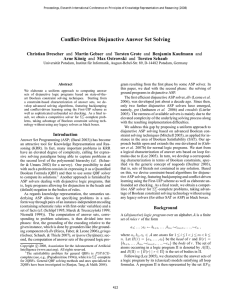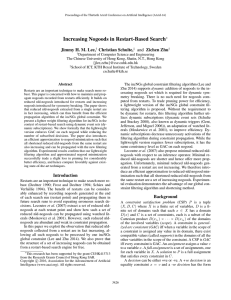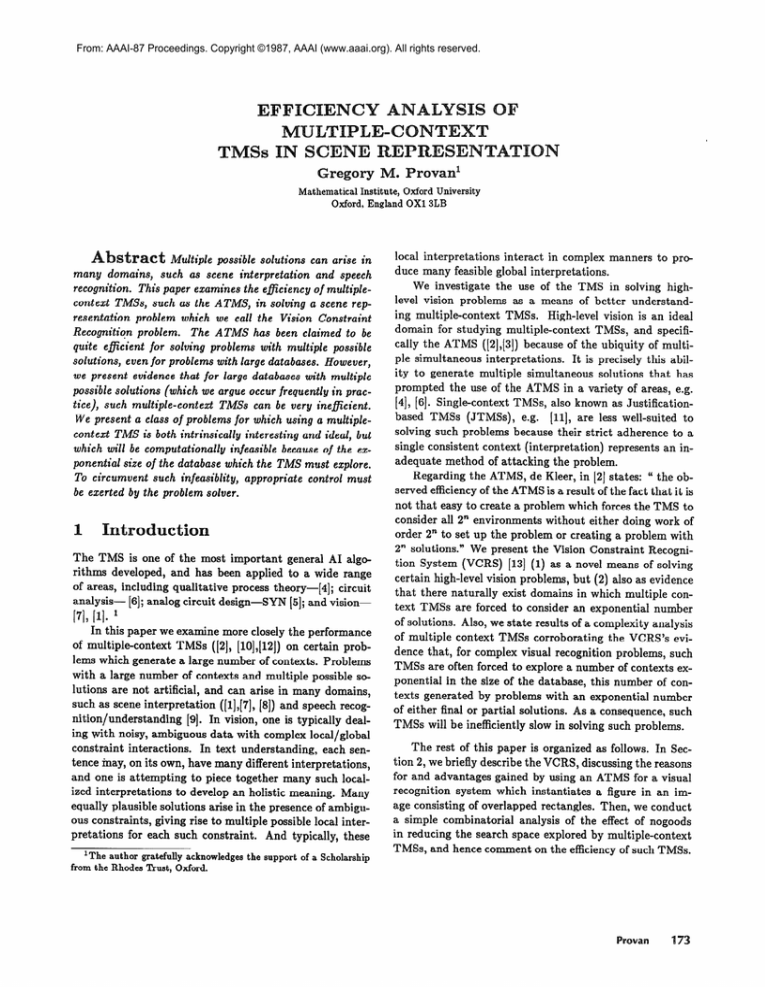
From: AAAI-87 Proceedings. Copyright ©1987, AAAI (www.aaai.org). All rights reserved.
Mathematical Institute, Oxford University
Oxford, England OX1 3LB
possible solutions can arise in
interpretation and speech
This paper examines the eficiency of multiple-
s&ract
many
Multiple
domains,
recognition.
context
TM%,
such
such
resentation
problem
Recognition
problem.
quite
eficient
we present
tice),
which
evidence
ATMS
ponential
Rowever,
in prac-
can be very o’neficient.
for which using a multiple-
is both intrinsically
which will be computationally
to be
possible
with multiple
we argue occur frequently
a class of problems
TMS
claimed
with large databases.
TMSs
rep-
Constraint
with multiple
that for large databases
(which
a scene
Vision
has been
problems
multiple-context
We present
in solving
we call the
The
for solving
solutions
such
context
as the ATMS,
even for problems
solutions,
possible
as scene
interesting
infeasible
and ideal,
because
but
of the ex-
size of the database which the TMS must explore.
appropriate
control must
such infeasiblity,
To circumvent
be exerted
by the problem
solver.
1
The TMS is one of the most important general AI algorithms developed, and has been applied to a wide range
of areas, including qualitative process theory-[4];
circuit
analysis- [6]; analog circuit design-SYN [5]; and vision1719PI. l
In this paper we examine more closely the performance
of multiple-context TMSs ([2], [10],[12]) on certain problems which generate a large number of contexts. Problems
with a large number of contexts and multiple possible solutions are not artificial, and can arise in many domains,
such as scene interpretation ([1],[7], [8]) and speech recognition/understanding [9]. In vision, one is typically dealing with noisy, ambiguous data with complex local/global
constraint interactions. In text understanding, each sentence may, on its own, have many different interpretations,
and one is attempting to piece together many such localized interpretations to develop an holistic meaning. Many
equally plausible solutions arise in the presence of ambiguous constraints, giving rise to multiple possible local interpretations for each such constraint. And typically, these
lThe author gratefully acknowledges
from the Rhodes !bust, Oxford.
the support
of a Scholarship
local interpretations interact in complex manners to pro
duce many feasible global interpretations.
We investigate the use of the TMS in solving highlevel vision problems as a means of better understanding multiple-context TMSs. High-level vision is an ideal
domain for studying multiple-context TMSs, and specifically the ATMS ([2],[3]) b ecause of the ubiquity of multiple simultaneous interpretations. It is precisely this ability to generate multiple simultaneous solutions that has
prompted the use of the ATMS in a variety of areas, e.g.
[4], 161. Sin d e-context TMSs, also known as Justificationbased TMSs (JTMSS), e.g. [ll], are less well-suited to
solving such problems because their strict adherence to a
single consistent context (interpretation) represents an inadequate method of attacking the problem.
Regarding the ATMS, de Kleer, in [2] states: “ the observed efficiency of the ATMS is a result of the fact that it is
not that easy to create a problem which forces the TMS to
consider all 2n environments without either doing work of
order 2n to set up the problem or creating a problem with
2n solutions.n We present the Vision Constraint Recognition System (VCRS) [13] (1) as a novel means of solving
certain high-level vision problems, but (2) also as evidence
that there naturally exist domains in which multiple context TMSs are forced to consider an exponential number
of solutions. Also, we state results of a complexity analysis
of multiple context TMSs corroborating the VCRS’s evidence that, for complex visual recognition problems, such
TMSs are often forced to explore a number of contexts exponential in the size of the database, this number of contexts generated by problems with an exponential number
of either final or partial solutions. As a consequence, such
TMSs will be inefficiently slow in solving such problems.
The rest of this paper is organized as follows. In Section 2, we briefly describe the VCRS, discussing the reasons
for and advantages gained by using an ATMS for a visual
recognition system which instantiates a figure in an image consisting of overlapped rectangles. Then, we conduct
a simple combinatorial analysis of the effect of nogoods
in reducing the search space explored by multiple-context
TMSs, and hence comment on the efficiency of such TMSs.
“hand,” the reason for that assignment, e.g. that
rectangle F, labeled “forearm,” overlapped G according to some constraint, is stored.
2 vision Constraint
System
(VC
Perception can be considered an interpretive
process, and
a key problem is interpreting descriptions computed for a
scene against a (typically large) database of models. Many
examples such as Rubin’s vase, Necker’s cube etc. teach
us that a single image (e.g. perfect line drawing) can have
several equally plausible perceptual interpretations. The
problem we are solving exemplifies these characteristics.
We use a multiple-context TMS precisely because of its
ability to generate multiple possible interpretations.
The specific high-level vision problem we have studied is called the Constraint Recognition problem, and is a
generalization of the PUPPET problem, first studied by
Hinton [8]. The problem solved by the VCRS is as follows:
given a set of (2-D) randomly overlapping rectangles and
a relational and geometric description of a figure (as described by a set of constraints over the overlap patterns
of k of these rectangles), find the best figure if one exists.
Our use of a TMS generalizes Hinton’s integer relaxationbased techniques by recognizing that the set of justifications which the TMS maintains for any database assertion
is isomorphic to an explicit perceptual interpretation for
that assertion.
Our plan for applying a multiple-context TMS to this
problem is as follows:
A TMS generates a justification structure for each
node, the structure indicating how that node was
assigned a label. This justification structure corresponds to a perceptual structure (e.g. rectangle A
is seen us a trunk, because rectangle B is seen as a
neck) by appropriate spatial relationships, etc.
Different perceptual interpretations correspond to different contexts.
Locally plausible visual fragments can be interpreted
in many ways and each interpretation is accorded a
context.
Taken together, the above points imply a large number of
contexts even for moderately complex visual input.
2.1
Advantages
of Using
a TMS
for Vi-
sual Interpretation
Let us now outline the advantages over relaxation-based
methods (e.g. [8]) afforded by a multiple-context TMS.
Studying many different alternative solutions. An algorithm which can explore multiple interpretations
simultaneously is more useful than one which explores one context at a time, as locally contradictory interpretations (which are outlawed for a singlecontext TMSs) may not necessarily indicate global
inconsistency but multiple global interpretations.
Utilizing updated input. The truth maintenance
aspect
of TMSs enables updating of databases with the input of new information. Both [l] and [7] use the TMS
for creating a consistent interpretation of stereo data,
for example.
Constraint-exposing.
Such a notion of semantics forms
the basis for a powerful constraint-exposing process,
one example of which is contradiction flagging. By
tracing justification paths for the nodes in a nogood
back to the assertions causing the contradiction, (identical to dependency directed backtracking), we can
identify incorrect/impossible assertions, rule these out,
and consequently eliminate all possible solutions based
on these global inconsistencies. In this manner, we
can rule out large portions of the search space.
Robust given noise. Scenes with noisy data occur frequently, and a TMS can extract interpretations from
noisy/ambiguous situations. This is achieved by the
TMSs’ justification structure “cutting through” noise.
Rectangles extraneous to the figure (e.g. a puppet)
will not be included in the justification structure and
will be ignored by the system.
Robust given occluded/incomplete
curs via two mechanisms:
scenes. This oc-
1. Automatic default mechanisms: these are incorporated in the TMS and can be used to fill out
incomplete (but plausible) figures.
2. Justified default mechanisms:
the justification
structure has an explicit notion of “completeness” of a figure, and can flag an almost-perfect
figure using a “closeness relationship” with respect to this notion of completeness. This gives
a semantics for the notion of defaults; for example, we might have “this default is an arm
because this figure would be a perfect puppet if
such an arm were presentn.
Explicit (domain dependent) constraints. An exphcit
notion of domain-dependent constraints has been found
Explicit semantics for images via justifications. TMSs
necessary to provide a powerful means of reducing
explicitly store justifications for all labeling assignthe search space. For example, in the detection of
Thus
if
rectangle
G
is
assigned
the
label
ment 5.
174
Automated Reasoning
puppet figures, such constraints include the representation of geometric structure in terms of posture
and global scaling. A puppet having a right and left
side, an upright or reclining posture introduces much
more powerful constraints (which can significantly reduce the search space) than if those concepts were
not present. Hence, an arm being a right arm rather
than a left arm determines the allowable angle of the
elbow joint quite specifically. A sense of global scaling is also crucial, as a thigh can be a thigh only in
proportional relation to the trunk and calf to which
it is attached.
2.2
Performance
of T
S within the VC
Let us now briefly outline some simple examples of problems the VCRS can solve. 2 In Figure 1, we see a sample
input for the VCRS, randomly overlapping rectangles in
which the target figure, a puppet, is distinguishable. Figure 1 shows a much-simplified example of the program’s
operation. Here we have a situation in which four orientations can produce a puppet, taking either A, B, 6, or D as
a head. For example, if B is chosen as a head, the partial
puppet (head, neck, trunk) consists of rectangles B, B’,
E. Moreover, it is ambiguity such as shown in this Figure
that gives rise to multiple contexts during search for a solution, as well as multiple possible solutions. When processing complicated scenes in searching for puppets, a multiple
context TMS builds a context for each possible puppet figure interpretation. Even for relatively simple cases we have
discovered that the number of contexts formed can be unreasonably large. In the above example, four environments
are necessary for just a small number of rectangles (A, A’,
B, B’, C, C’, D, D’, E).
Let us now look at two inter-related reasons why a very
large number of environments will need to be constructed
for this problem, which results in the ATMS creating an
exponentially large number of contexts.
Size of nogoods expected For complex figures, once we
have found a seed, it is reasonably easy to form the
first few elements of the figure, and it then becomes
increasingly difficult, with inconsistencies more liable
to occur. This means that, of the seeds found, the
majority of the nogoods found will be of size 2 k,
with k dependent on the complexity of the problem.
Thus, if there are 100 seeds found and k w 10, the actual space which must be searched is extremely large,
as the nogoods of large size, as shown in Section 3,
will not reduce the search space very much even if
there are many such nogoods.
Expected number of partial solutions The number of
environments constructed increases rapidly as problem2Forfulldetails
consult
[13].
Figure 1: VCRS Example for Detecting a 15-element Puppet
solving progresses. Consider a partial puppet consisting of a head, neck and trunk (A, A’, E respectively).
As in Figure 1, if this trunk has 4 overlaps which
could be upper arms and 4 which could be thighs,
42
we can have 02 = 36 possible interpretations. Now,
if an upper arm and a thigh have 2 possible fore-arms
52
and calves respectively, this gives 02 = 100 interpretations. Even for this very simple example we can
already see the combinatorial explosion of the number of necessary environments. This combinatorial
explosion grows even faster (i.e. is more serious) the
more complex the scene and the figure for which we
are looking. This points out that, even if we end up
finding just a few full figures, there may be an exponential number of environments for the partial figures
at an intermediate stage of the solution process.
We now present theoretical evidence to corroborate these
empirical results.
Questions concerning the complexity of the ATMS were
first mentioned with reference to a parity problem ([3],
[111). We will now analyse some issues raised by problems
such as the parity and visual constraint recognition problems. But before beginning this analysis, we shall formally
state the problem.
Provan
175
3.1
Problem
Definition
Consider that we have a problem with n distinct facts,
forming the fact set A. We call the set of environments
the power set of A, A = PA. Within this power set there
are subsets which are inconsistent. We call such inconsistent subsets nogoods, and the consistent subsets contexts.
We denote the set of contexts C & A. There are 2” environments and (;) environments with k facts. A minimal
nogood is a subset B from which removing a single fact
will leave either the null set or a context. It is important
to note that all supersets of a nogood set are also nogood
sets. Let us call the size of the minimal (or “seed”) nogood
set Q, size meaning the number of facts contained in the
nogood.
In the following discussion, we shall be referring to a
general algorithm which attempts to determine all maximal contexts, where a maximal context is a set C* C C such
that either: (1) ] C* ] = n, or (2) C*U{U} is inconsistent for
all facts a E A \ C*. Such an algorithm proceeds by forming all subsets (representing partial solutions), first of size
1, then of size 2, etc. until we produce maximal contexts.
Nogoods are used to prune the search space by eliminating
all supersets of minimal nogoods from the search space. It
must be noted that, in its full generality, this algorithm,
referred to as interpretation construction in [2], is isomorphic to the minimum set covering problem (which is NPcomplete). The ATMS utilizes the most efficient method
of interpretation construction given the specific problem,
but for certain problems the exponential complexity is unavoidable, and is unavoidable for any algorithm searching
multiple contexts.
The example of algorithm which we shall be using is
the ATMS, although this analysis is equally valid for algorithms which use a similar multiple-context approach. We
will now isolate the factors necessary to avoid exponential
growth of the search space. In this analysis, we show the
power of nogoods of small size in cutting down the number
of contexts, and hence the size of search space. We also see
that even for problems in which the number of solutions is
non-exponential in the problem size n, the number of partial solutions could still be very large, and hence produce
an unreasonably large number of contexts.
3.2
Analysis of Search-Space
Using Nogoods
Reduction
We begin this combinatorial analysis by looking at how
nogoods reduce the search space. We introduce the problem with the simplest case, that in which the seed nogoods
are non-overlapping. An overlap occurs between two seed
(or minimal) nogoods ngl and ng2 if ngl n ng2 # 0. A
non-overlapping problem is one in which none of the seed
nogoods have overlaps: for the set U of seed nogoods,
E U, i # j. We then proceed
wi n ngj = 0, Vngi,ngj
176
Automated Reasoning
to more general cases, analyzing the complex nogood interactions when we have overlapping of seed nogoods. Due
to space limitations, we provide just a sample of our results
without proofs, and refer the reader to [13] for these proofs
and a more intelligible analysis.
3.2.1
Non-overlapping
Nogood
Analysis
Lemma 1 For a problem
with n distinct
(minimal)
nogoods each of size Q produces
Q(x,
non-overlapping
oz) total nogoods,
facts,
x
“seed”
where
@(x, a) = 2,-,(
2 - 2F”b4)+“1(1-
Lemma 1 describes the size of space generated by nonoverlapping nogoods all of equal size.
Lemma 2 For a non-overlapping
problem with a nogoods
of size cy, b nogoods of size p, c nogoods of size 7, etc., an
upper bound for the number of nogoods formed is given by
@((~,a),
(b,p),
(c,7), ..) 5 2”(~2-~
+ b2-a
+ ~2-~+
. . . . ).
Lemma 2 extends Lemma 1 to cases of non-overlapping
nogoods of different sizes.
Given that we know the search-space reduction achieved
by non-overlapping nogoods, we next investigate the reduction achieved by nogoods of specific sizes.
Corollary
then,
1.
1 For cdl n, (Y >
to a close approximation,
&
is constant
2. The eect
3.
independent
0, if A,
=
$$$,
of n,
of a nogood in reducing the search
inversely
proportional
qy$
=
x 1 2,
A,,
space is
to its size,
I/2.
Corollary 1 shows that the size of the nogood has a significant effect on this reduction. More importantly, Corollary 1 implies that the reduction in the size of the search
space is inversely proportional to the size of the seed nogood, and in fact diminishes by l/2 as the size of the nogood is increased by 1. This means that, for the largest
reduction of the search space, it is best to have nogoods as
small as possible.
We have completed a simulation of this combinatorial
analysis which provides empirical confirmations to our analytic results. Namely, the % reduction is independent of
n, the size of the problem, and it is most advantageous to
have minimal nogoods of as small a size as possible.
3.2.2
Overlapping
Nogood
Analysis
We now turn to an analysis of multiple overlapping nogoods. The difficult aspect is modeling the complex in-
teractions of the nogoods, namely taking account of the
complicated manner in which overlapping of nogoods occurs when several nogoods are present; it is important not
to double-count supersets of nogoods.
Lemma
3 A problem
in which overlaps of nogoods occur
to one in which they do not occur.
is convertible
Lemma 3 implies that many of the results which we
have obtained so far for non-overlapping problems can be
used for this more complicated case. Let us now state one
of the major results of [13], an upper bound on the size of
the search space reduction by a set of nogoods.
Theorem
purumeters
lapping
@((a,a),
Ih An upper
(( a+),
randomly,
(b,@,
bound for a problem
(b,BL(c,7),..),
is given by
(c,7),..)
<
2n(a2-Q
defined
by the
with the nogoods
+ b2-@ + ~2-~+
over-
. . . . ).
Our (worst-case) problem is still 0(2n) over a wide
range of nogood parameters ((a, cy), (b, p), . ..). It must be
emphasized that the value of 2n for n = 100 is 1.26 x lOso,
so even for relatively large search-space reductions, a huge
amount of the search-space still remains. From the previous section, we see that nogoods cut down this number.
However, any problem which forces the ATMS to construct
a substantial portion of the environment lattice will cause
inefficient ATMS performance.
The real problem is that ATMS interpretation construction is intrinsically NP-complete. We have just described a problem which brings out this exponential behaviour. The solution to such a combinatorial explosion
of the solution space is either ensuring the constraints will
generate small nogoods or carefully controlling the problemsolving. The principal aim of this latter course of action is
to constrain the ATMS to look at one solution at a time, using a dependency-directed backtracking mechanism or employing consequent reasoning and stopping when a single
solution is found (i.e. to revert to JTMS-style behaviour).
This, however, appears to be an extreme reaction, since for
problems such as this, exploring multiple solutions would
be ideal.
Our two main complexity results are the following: first,
problems such as the visual constraint recognition problem
described here can have a very large number of solutions,
and such problems are not pathological (as claimed by de
Kleer in [2]) b u t occur naturally. To the contrary, we argue
that the most challenging problems facing AI are exactly
those with multiple possible solutions. Second, as again
cited by deKleer [2], y ou do not need a problem with 2”
solutions to make the ATMS infeasibly slow. Even with a
fraction of these solutions the ATMS can “blow up.” This
is because cases exist in which problems with a moder-
ate number of complete solutions may have an exponential
number of partial solutions, forcing the ATMS to construct
an exponential number of intermediate contexts.
One important contribution of this research is the beginning of a classification of problems for which different
TMSs are suited. The performance of JTMSs and ATMSs
is highly problem-specific, and as yet little or no empirical or theoretical work has been done to define a better
problem classification based on TMS efficiency.
There is no doubt that for moderately-sized problems
there are many cases for which the ATMS is the most efficient TMS algorithm. However, for large and complex
problems (e.g. vision and speech-understanding problems),
this efficiency can be lost in constructing an environment
lattice whose size is often exponential with respect to the
database size.
Acknowledgements
I have received a great deal of comments and encouragement from Mike Brady. Many thanks to Johan de Kleer
and Ken Forbus for providing me with their TMSs.
PIJ. Bowen
and J. Mayhew. Consistency Maintenance in
Environment.
Technical Report AIVRU
020, University of Sheffield, 1986.
J. de Kleer. An assumption-based TMS. AI Journal,
28:127-162, 1986.
J. de Kleer. Problem solving with the ATMS. AI Journal, 28:197-224,
1986.
141J. de Kleer and J. Brown. A Qualitative Physics Based
on Confluences. AI Journal, 24:7-83, 1984.
J.
PI de Kleer and G. Sussman. Propagation of Constraints
Applied to Circuit Analysis. Circuit Theory and Appbications, 8, 1980.
PI .J. de Kleer and B. Williams. Diagnosing Multiple Faults.
AI Journal,
1987, to appear.
I71M. Herman and T. Kanade. Incremental Reconstruction of 3D Scenes from Multiple, Complex Images. AI
Journal,
30:289-341,
1986.
G.E.
Hinton.
Relaxation
and its Role in Vision. PhD
PI
thesis, University of Edinburgh, 1977.
PI V.R. Lesser and L.D. Erman. A Retrospective View of
the Hearsay-II Architecture. In Proc. IJCAI, 1977.
[lo] J. Martins and S. Shapiro. Reasoning in Multiple Belief Spaces. In Proc. IJCAI:370-373,
1983.
[ll] D. McAllester. A Widely Used Truth Maintenance
System, unpublished, 1985.
[12] D. McDermott. Contexts and Data Dependencies: a
Synthesis. IEEE Trans. PAMI, 5(3):237-246,
1983.
[13] G. Provan. Using Truth Maintenance Systems for
Scene Interpretation: the Vision Constraint Recognition System (VCRS). Robotics Research Group RRG7, Oxford University, 1987.
the REVgraph
PI
PI
Provan
177

